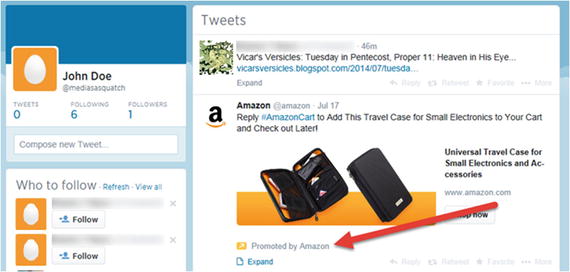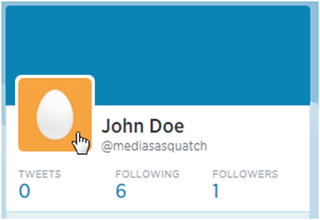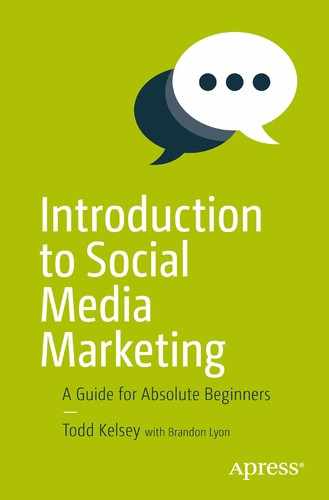This chapter looks at Twitter as a social media marketing channel, discusses its pros and cons, and walks through the process of creating a Twitter account.
Twitter: To Do or Not to Do ?
Although I believe it’s wise to see the social media marketing landscape as prone to shifting, Twitter is considered to be a “mainstay” channel . It’s one of the networks that companies often post to. As with Facebook, there’s no right or wrong way to use it, or not use it. That said, the best questions to ask is what audience you want to address and is that audience on Twitter?
As with Facebook , people are generally less likely to have “purchase intent” when on Twitter (as compared to searching on Google), but this could change. Just like Facebook, Twitter has explored advertising. A fair amount of people spend time on Twitter, and they’re generally a younger demographic and probably more prone to being interested in exchanging news and information.
It’s also fair to say that for the segment of the population that uses Twitter, it’s increasingly common to “tweet” (post something) about issues that a person is having with a product or service. When discussing social media marketing, you invariably end up having to consider the conversation as “two-way”. Even if you don’t advertise on Twitter, you may want to become familiar with how people are tweeting about your company or organization . The bigger the company is, the more likely people will expect that if they tweet about an issue they’re having, the company will join in on the conversation from a customer service perspective.
My general recommendation is to become familiar with Twitter, to look at some of the techniques for developing and maintaining a presence on Twitter, and to think critically about its ROI, as with other channels.
If you’re in the position of pitching or developing a baseline social media presence for a company or organization (or person) that knows they want to be on social media, it might be helpful to think about Twitter as one of several channels that you can post to.
Note
Start with a plan of posting regularly to a blog or help a business owner or organization post regular blog articles, and then work to post those blog articles to Facebook and Twitter, in order to maintain a presence on these channels.
It’s a bit hard to make generalizations on the effectiveness of a particular social media channel, but I do think that Twitter is at least worth trying. Be sure to at least monitor it and become familiar with it.
A High-Level Overview of Twitter
To understand how Twitter works, you can look at a Twitter page without being “on” Twitter. For example, take a look at www.twitter.com/reuters .
This is an example of a very common use of Twitter —to exchange the latest news about whatever (in this case, it’s Reuters, an official news organization):

Twitter posts are limited to 140 characters , so the general format is some kind of very concise comment, often with a link to an article or picture, and then some conventions that are somewhat unique to Twitter.
For example, in the previous graphic in the second post, there is @reuters – this is like a “ping”. If I wanted to mention Reuters in my own tweet, if I include @ reuters, Reuters can scan Twitter and see that the post mentions their username. The @ sign is basically a way to notify another Twitter user about something connected to them.
Another common thing on Twitter, which you’ll sometimes see on television news or in media discussion, is a hash tag , such as #computers or #apple. It’s basically another kind of tag. If you include this kind of text in a Twitter post, you are associating the post with any other post that is using the tag. So hash tags will commonly become popular around events or popular topics, such as #worldcup, or around celebrity names, etc.
In addition to news, Twitter is often used by companies and brands. For example, Oreo has an active Twitter page at www.twitter.com/oreo .
Are they posting about real “news”? Not particularly; just seeking to make interesting posts .

As much as I believe that it’s important to think about return on investment in social media, it’s fair to say that a good portion of what goes on in social media basically amounts to show and tell, where effective posts can simply be entertaining. They can catch someone’s attention because they’re bored, not necessarily because they’re looking to purchase something.
It’s also fair to say that Twitter is used extensively for entertainment purposes. Here’s a list of some top Twitter accounts at the time of this writing:

Another area to be familiar with is customer service. Many people tweet about products , and it is a best practice for a company to keep an eye on social media. An upset customer is more likely to start a firestorm on social media, and it can quickly get out of control if you don’t address it.
Some are useful because they offer deals and customer service. Others are just plain entertaining.
Here’s a sample post that someone made. Notice how they referenced @BofA_Community—it’s the “ping” I was talking about. If the Bank of America is paying attention, they could respond.

Bank of America did respond, because they have a social media team who is out there keeping an eye on things. Keep in mind that these days there are people out there who won’t bother e-mailing or calling a business, but they will tweet. Tweeting does not necessarily mean going on a web site and entering a post—many people tweet right from the text message function on their phone . This is part of the reason that the Twitter app spread so fast—because it is fairly simple and you don’t even need a computer to use it.
Creating a Twitter Account
To start exploring Twitter, go to twitter.com and enter your name, e-mail address, and a password.

Next it will flip you to a screen where you can choose a username. This will become twitter.com/yourusername.
Keep trying usernames until you find one that’s available and you like:

Then, click Create My Account :

Just like Facebook does, Twitter regularly changes or “improves” the way things work. At the time of this writing, the sign-up process seemed to force you through a tutorial, so you can just keep on clicking on the Next button:

It helps you to see how things work—in this case it is showing you how to “follow” people. In theory, you don’t need to follow anyone, but when you find accounts to follow, they are notified, and often will follow you as well. One way of building a Twitter following is to find other accounts to follow. Whether people actually read each other’s posts is another question that depends on how relevant and interesting they are to the person. But that’s the basic part of it.
You can just click on a few people it suggests:

At some point, you’ll get a confirmation e-mail:

You just need to click on the Confirm Your Account Now button:

If you get annoyed with the step by step wizard, you can always go directly to twitter.com. It will probably look something like this, with some tweets on the right side from people you are following, and a “promoted” tweet (see the arrow). Promoted tweets are a form of advertising on Twitter that you can also explore.

To get to your own Twitter page , click on the profile icon/name:

Posting to Twitter
To get to your page, you can sign in and click on your profile icon, or you can go to twitter.com/yourusername, such as:
https://twitter.com/mediasasquatch
If you haven’t yet, you can add a photo or follow the introductory suggestions:

In general, to tweet , you just go to the upper-right corner of the screen and click on the Tweet icon:

For example (nudge nudge), if you created a blog as suggested in Chapter 2, you can tweet your blog’s address:

Twitter will give you a running count of how many characters you have left in the tweet. If you run over, Twitter will split it into an extended post or into multiple posts, and you’ll generally want to keep posts under 140 characters .
After you enter the text , click Tweet and voila! You have posted to Twitter:

Then, in theory, as with newsfeeds in Facebook, the tweet should appear in someone else’s Twitter feed. I believe, until/unless things change, if a person were to log on to Twitter and read every tweet from someone they were following, they would see yours. Unlike Facebook, you don’t need to “promote” a tweet in order for someone to see it. But don’t be surprised if Twitter goes from theoretically unrestricted access to tweets to “monetizing” them in some way.
ROI and Strategy of Twitter
An entire industry has grown up around marketing on Twitter, including leveraging advertisements, promoted tweets, etc. If you’re just learning about what’s possible, or you want to know what kinds of services could be offered to a business or organization, I recommend taking a look at these sites:

In terms of return on investment , at least in theory, if your business is selling a product, you can include promotions, coupons, and offers, just like you can in an offer on Facebook. Part of the science of tracking ROI in that case is including links that allow you to calculate the conversion rate—“Of the number of people who came to our site from Twitter based on that link, how many actually purchased something”?
Learning More
Twitter has some good learning material at https://support.twitter.com .
I also recommend taking a look on Google at topics such as “Twitter marketing” and “ROI on Twitter”, something like “Twitter best practices”, or “leveraging Twitter for customer service”.
You can also explore these links:
Conclusion
Congratulations on learning about Twitter! As with some of the other social networks, the best way to learn is to try it a bit and to look at how other people are using it. One of the common things that happens with Twitter (and Facebook for that matter) is that an individual, business, or organization starts out with a “gung-ho” approach, spending lots of money and time. The regularity of posting will then drop off, and their social media presence will languish. This is why, in spite of how important it is to become familiar with Twitter, it’s helpful to consider that it still comes down to content. Ask, what are you going to post? A sustainable, ongoing content strategy should be a central part of any social media effort.
Yes, establish a social media presence for yourself or for your business, but not without a realistic, sustainable plan for regular posts—whether those posts are offers, news, promotions, or just share information about the organization. I highly suggest starting out with modest goals, such as a monthly or weekly post, and when you’ve regularly posted for a while, consider posting more. Over the long term, it’s better to post regularly, at higher quality, and with more attention. I guess I’m a believer in blog posts for that reason.
